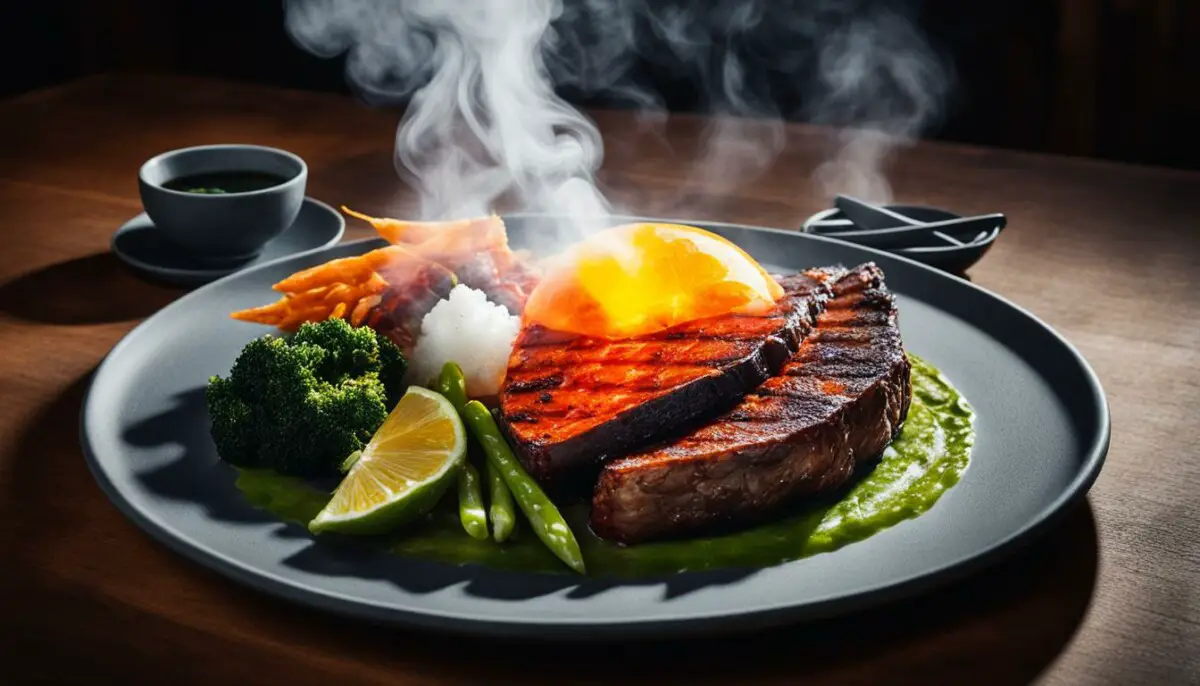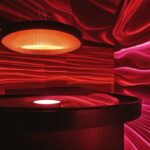Last Updated on 4 months by Francis
Welcome to our informative article on the fascinating topic of infrared lamps and their ability to warm food. Have you ever wondered if these innovative devices can effectively heat your favorite dishes? Well, you’ve come to the right place to find out!
Infrared technology, a form of radiation within the electromagnetic spectrum, has the potential to heat food efficiently. With a wavelength ranging from 0.5 to 100 µm, infrared rays can penetrate the surface of food and cause the water molecules to vibrate, resulting in gentle and effective heating. This technology boasts numerous advantages, including high energy efficiency, precise control over heating, improved product quality, and enhanced food safety.
However, it’s essential to exercise caution when using infrared lamps, as prolonged exposure to infrared radiation can cause burns and tissue damage. By understanding the working principles of these lamps and considering their benefits and limitations, you can make informed decisions about incorporating them into your food warming practices.
Contents
Key Takeaways:
- Infrared lamps can efficiently warm food by emitting infrared radiation and causing water molecules to vibrate.
- These lamps offer advantages such as high energy efficiency, precise temperature control, improved food quality, and enhanced safety.
- However, prolonged exposure to infrared radiation can lead to burns and tissue damage.
- Choosing the appropriate heat lamp is crucial based on the type of food and desired warming process.
- Incorporating infrared lamps into food preparation can enhance efficiency and ensure proper food warming.
How Does Infrared Lamp Warm Food?

Infrared lamps are an effective way to warm food, utilizing the principles of infrared radiation. When an infrared lamp is turned on, it emits infrared waves that are absorbed by the food’s surface. The radiation causes the water molecules within the food to vibrate, resulting in heat production. This process warms the food without the need for direct contact, making it an efficient and convenient method for warming meals.
Using an infrared lamp to warm food offers several benefits. First and foremost, it provides high energy efficiency compared to traditional heating methods. This means that less energy is wasted, resulting in cost savings and reduced environmental impact. Moreover, the precise temperature control offered by infrared lamps ensures that the food is heated evenly without the risk of overheating or burning.
“Infrared lamps provide high energy efficiency, precise temperature control, improved product quality, and food safety.”
Infrared lamps also contribute to improved product quality. The gentle and uniform warming process helps to maintain the moisture content and texture of the food, preventing it from becoming dry or soggy. Additionally, the use of infrared radiation for food warming does not produce harmful byproducts or release volatile organic compounds, making it a safe and clean option.
It is important to note that the warming capabilities of infrared lamps are most effective for food with a small surface area or when used for short periods of time. The infrared radiation primarily heats the surface of the food and may not penetrate deeply. Therefore, it may not be suitable for warming large portions of food or dishes with significant thickness.
Benefits of Using Infrared Lamp for Warming Food:
- High energy efficiency
- Precise temperature control
- Improved product quality
- Food safety
- Environmentally friendly
Overall, the use of an infrared lamp to warm food offers numerous advantages, from energy efficiency to enhanced product quality. By harnessing the power of infrared radiation, businesses and individuals can enjoy efficient and effective food warming solutions.
Advantages of Using Infrared Lamp for Warming Food
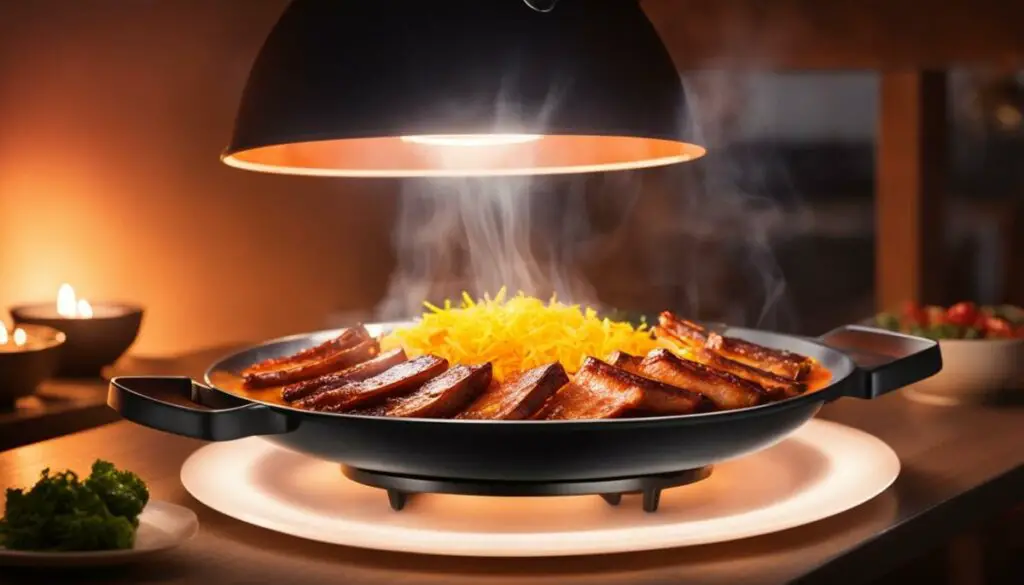
Using an infrared lamp for warming food offers several advantages. Firstly, it is highly energy-efficient, consuming less energy compared to traditional heating methods. This results in cost savings and reduced environmental impact.
Secondly, infrared lamps provide precise temperature control, allowing for consistent and uniform warming of the food. This helps to maintain the quality of the food and ensures even heating.
Additionally, infrared lamps do not produce heat-recycling or volatile organic compounds, making them a safe and clean option for warming food. They are also compact in size, easy to control, and offer fast heating, increasing efficiency in food preparation.
With these benefits, incorporating infrared lamps into food warming processes can bring significant improvements to energy consumption, food quality, and overall efficiency.
As shown in the image above, the use of an infrared lamp as a food warmer offers various advantages:
| Advantages of Using Infrared Lamp for Warming Food |
|---|
| High energy efficiency |
| Precise temperature control |
| Improved food quality |
| Safe and clean option |
| Compact size and easy control |
| Fast heating |
Infrared Lamp for Cooking Food

In addition to warming food, infrared lamps can also be used for cooking. The high energy efficiency and precise temperature control make infrared lamps suitable for various cooking processes. They can be used for baking bread, roasting food, manufacturing juices, and cooking a variety of dishes. The infrared radiation emitted by the lamps heats the food quickly and evenly, resulting in enhanced cooking efficiency and improved food quality. However, it is important to ensure that the food is properly cooked and meets safety guidelines.
When using an infrared lamp for cooking food, it’s essential to follow proper cooking guidelines to ensure food safety. Here are a few key considerations:
- Before cooking, ensure that the food is properly thawed and seasoned.
- Place the food on a suitable cooking surface that allows for even heat distribution.
- Position the infrared lamp at an appropriate distance to prevent overheating or burning.
- Monitor the cooking process closely and adjust the lamp’s intensity or distance, if needed, to maintain the desired temperature.
- Use a food thermometer to check for proper internal temperature to ensure that the food is cooked thoroughly.
- Follow any additional cooking instructions or recipes for specific dishes.
By using infrared lamps for cooking, you can take advantage of their energy efficiency, precise control, and fast heating capabilities. Whether you’re baking, roasting, or cooking various dishes, infrared lamps can help you achieve excellent results and enhance the overall cooking experience.
Infrared Lamp as a Food Warmer
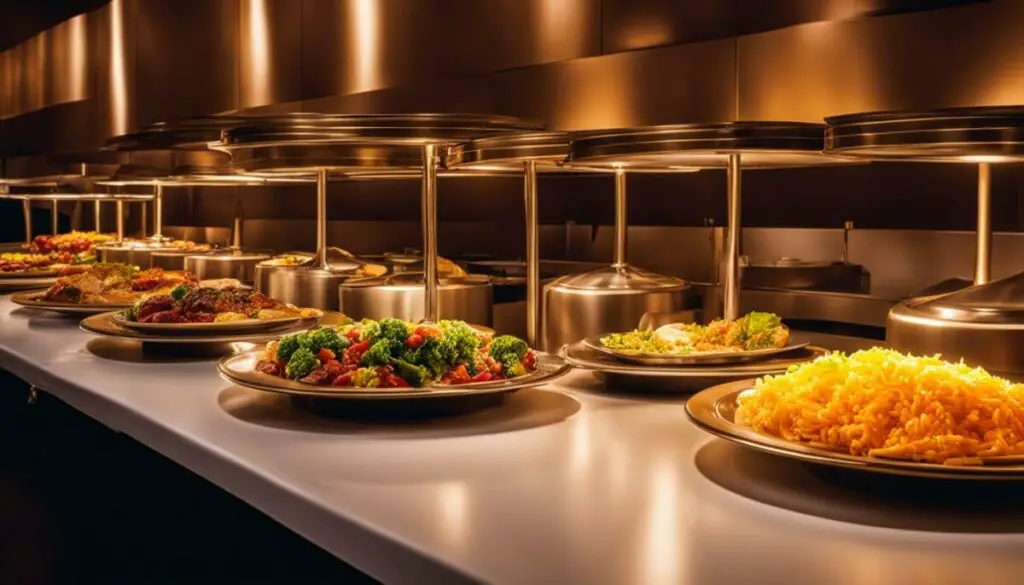
Infrared lamps are commonly used as food warmers in restaurants, catering services, and buffet lines. Their ability to emit infrared radiation allows them to keep prepared food at the perfect temperature for a short time until ready to be served. Infrared lamps act as a warming agent without continuing the cooking process, preventing the drying out of food. They are ideal for areas such as buffet lines, expo counters, and carving stations, where maintaining the proper temperature of food is crucial.
Using an infrared lamp as a food warmer offers several advantages:
- Retains the optimal temperature: Infrared lamps emit heat that keeps food warm and ready to be served without further cooking. This helps preserve the taste, texture, and quality of the food.
- Prevents drying out: Unlike traditional heating methods, infrared lamps provide gentle heat that prevents food from drying out, ensuring it remains moist and delicious.
- Efficient and quick: Infrared lamps heat food quickly and efficiently, allowing for fast and convenient food service. They are designed to provide rapid heating without preheating time.
- Wide range of applications: Infrared lamps are versatile and can be used in various settings, including buffet lines, expo counters, and carving stations. They are suitable for both small and large food quantities.
- Safe and easy to use: Infrared lamps are safe to handle and operate. They feature adjustable controls for temperature settings and often have built-in safety features to prevent overheating.
However, it is important to note that infrared lamps should not be used for extended periods of time as they can dry out the food due to the dry heat emitted. It’s essential to use them as food warmers for a short period until the food is ready to be served.
Quote:
“Infrared lamps provide consistent warmth and are a reliable tool in maintaining the ideal temperature for food, ensuring it stays delicious and ready to be served.” – Chef Emily Thompson
Types of Heat Lamps for Warming Food
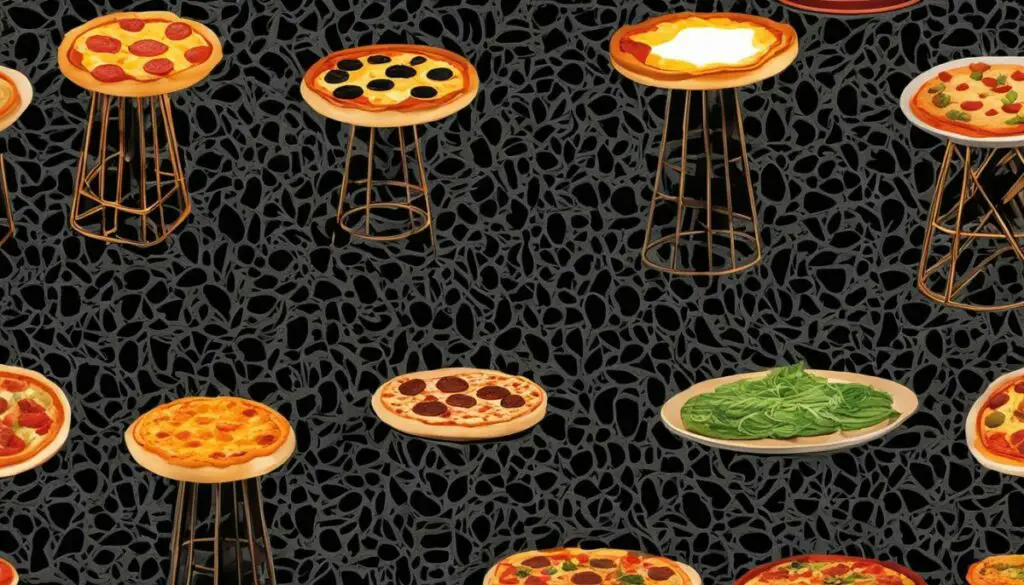
When it comes to warming food, there are different types of heat lamps available that cater to various needs. Here are some of the most common types:
Hanging Heat Lamps
Hanging heat lamps are ideal for buffet lines or expo counters. They are suspended from low-hanging ceilings, providing a convenient and efficient way to keep food warm. These lamps offer versatility in terms of placement and can be adjusted to accommodate different serving areas.
Ceiling Heat Lamps
Ceiling heat lamps are designed to be hardwired and permanently mounted to the ceiling. These lamps provide a uniform distribution of heat in a fixed location and are commonly used in commercial kitchens or large-scale operations. However, they lack mobility and cannot be moved to different areas.
Countertop Heat Lamps
Countertop heat lamps offer an economical choice for smaller holding areas. These lamps can be easily moved and plugged in elsewhere, making them versatile and flexible. They provide low-intensity heat, making them suitable for maintaining the temperature of plated food or smaller serving zones.
Strip Heat Lamps
Strip heat lamps, also known as freestanding heat lamps, feature rows of heating elements that emit efficient and intense heat. These lamps are often hardwired and provide consistent warmth across the entire length of the lamp. Strip heat lamps are commonly used in professional kitchens and are perfect for maintaining the ideal temperature for large quantities of food.
Here’s a visual breakdown of the different types of heat lamps:
| Heat Lamp Type | Description |
|---|---|
| Hanging Heat Lamps | Suspended from low-hanging ceilings, versatile placement options |
| Ceiling Heat Lamps | Hardwired, fixed location, uniform heat distribution |
| Countertop Heat Lamps | Economical, portable, low-intensity heat |
| Strip Heat Lamps | Freestanding, intense and efficient heat |
Each type of heat lamp offers unique features and advantages, making it important to choose the right one for your specific needs. Consider factors such as the size of the holding area, the mobility required, and the desired intensity of heat before making a selection.
Benefits and Considerations of Using Heat Lamps for Warming Food
Using heat lamps for warming food offers several benefits. They provide a reliable and consistent source of heat, ensuring that food is kept at the desired temperature. Heat lamps are preferred for buffet lines and expo counters where a large area needs to be heated. They are also economical and can be moved to different locations.
Heat lamps offer the following benefits:
- Reliable and consistent heat source
- Efficiently warm larger areas
- Cost-effective and portable
However, it is important to consider the limitations of heat lamps. They should not be used for extended periods of time as they can dry out the food. Additionally, ceiling-mounted heat lamps may restrict the flexibility to rearrange the kitchen layout if needed.
Consider the following limitations:
- Drying out food if used for too long
- Potential restrictions in kitchen layout
Despite these considerations, heat lamps remain a popular choice for efficiently and effectively warming food.
| Benefits | Considerations |
|---|---|
| Reliable and consistent heat source | Drying out food if used for too long |
| Efficiently warm larger areas | Potential restrictions in kitchen layout |
| Cost-effective and portable |
As shown in the table above, the benefits of using heat lamps for warming food outweigh the considerations, making them a valuable tool in the food service industry.
Mounting Styles and Controls for Heat Lamps
When it comes to mounting heat lamps, there are various styles available to suit different applications. Whether you need to warm food on a buffet line, create a carving station, or customize a display, there’s a mounting style that can meet your specific requirements.
Suspended Heat Lamps
Suspended heat lamps are designed for large areas and are typically hardwired for installation. They feature multiple bulbs mounted on suspension bars, providing heat to buffet lines or other extensive food service areas. With their versatile design, suspended heat lamps ensure even heating and efficient food warming.
Countertop Heat Lamps
For those looking for flexibility, countertop heat lamps are an excellent choice. These lamps are mounted on a stand for stability and can be easily moved to different locations as needed. The design allows food pans to slide directly under the bulbs, ensuring convenient and efficient food warming.
Clamp-On Mounted Heat Lamps
If you need a heat lamp that can be mounted to countertops or tables, clamp-on mounted heat lamps are the answer. These lamps offer flexibility in creating a carving station or customized display. Simply clamp them onto the desired surface, and you’re ready to go. The versatility of clamp-on mounted heat lamps makes them a popular choice for various food service setups.
Heat lamps are relatively easy to operate, with most units featuring toggle on/off switches or infinite switches for temperature control. This allows for convenient and precise adjustments to meet your specific warming needs.
Now that you’re familiar with the different mounting styles and controls for heat lamps, you can choose the option that best suits your food warming requirements. Whether you’re operating a buffet line, catering service, or restaurant, the right heat lamp can enhance your food preparation efficiency and ensure your dishes are served at the perfect temperature.
Conclusion
Infrared lamps are a game-changer when it comes to warming and cooking food. With their ability to offer precise temperature control, improved product quality, and reduced environmental impact, they have become a popular choice in various food settings, including restaurants, catering services, and buffet lines.
When considering the type of food and the desired cooking or warming process, it’s essential to choose the appropriate heat lamp. By incorporating infrared lamps into food preparation, businesses can enhance their efficiency and ensure that the food is safely and properly warmed or cooked.
By harnessing the power of infrared technology, food establishments can take advantage of the many benefits these lamps offer. From energy efficiency to high-quality results, infrared lamps provide a reliable and eco-friendly solution for keeping food at the perfect temperature. So, whether you’re serving up a hot buffet or cooking a delectable dish, infrared lamps are here to revolutionize the way we heat our food.
FAQ
Can an infrared lamp warm food?
Yes, an infrared lamp can warm food by emitting infrared radiation, which is absorbed by the food’s surface and causes the water molecules to vibrate, resulting in heating.
How does an infrared lamp warm food?
An infrared lamp warms food by emitting infrared radiation, which penetrates the food’s surface and causes the water molecules to vibrate, resulting in heating.
What are the benefits of using an infrared lamp for warming food?
Using an infrared lamp for warming food offers several advantages, such as high energy efficiency, precise temperature control, improved product quality, and food safety.
Can an infrared lamp be used for cooking food?
Yes, an infrared lamp can be used for cooking food. It provides high energy efficiency and precise temperature control, making it suitable for various cooking processes.
How can an infrared lamp be used as a food warmer?
An infrared lamp can be used as a food warmer by emitting infrared radiation to keep prepared food at the perfect temperature for a short time until ready to be served.
What are the different types of heat lamps for warming food?
There are different types of heat lamps for warming food, including hanging heat lamps, ceiling heat lamps, countertop heat lamps, and strip heat lamps.
What are the benefits and considerations of using heat lamps for warming food?
Using heat lamps for warming food provides a reliable and consistent source of heat, but caution should be exercised to prevent drying out the food.
What are the mounting styles and controls available for heat lamps?
Heat lamps can be mounted in various styles, such as suspended, countertop, and clamp-on. They usually have toggle on/off switches or infinite switches for temperature control.
Can heat lamps be used for extended periods of time?
Heat lamps should not be used for extended periods of time as they can dry out the food. It is important to follow safety guidelines and ensure the food is properly cooked and warmed.
Where can infrared lamps and heat lamps be used for warming food?
Infrared lamps and heat lamps are commonly used in restaurants, catering services, buffet lines, and other food preparation settings where maintaining the proper temperature of food is crucial.
Can infrared lamps and heat lamps help to enhance food preparation efficiency?
Yes, by incorporating infrared lamps and heat lamps into food preparation, businesses can enhance their efficiency in warming and cooking food, resulting in improved quality and customer satisfaction.

